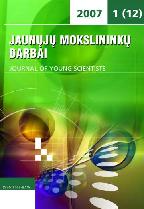Work Motivation: a Vector Approach
Work Motivation: a Vector Approach
Author(s): Ivan KotliarovSubject(s): Social Sciences
Published by: VšĮ Šiaulių universiteto leidykla
Keywords: Motivation; vector; needs.
Summary/Abstract: Effective control of an economic phenomenon requires a mathematical model able to provide a reliable qualitative description of this phenomenon and to ensure quantitative forecasts of its characteristics. Our understanding of the nature of human motivation did gradually improve over the years (we have now many more or less consistent theories giving adequate descriptions of motivation processes), but a good mathematical model of work motivation is not available. In fact the only example of mathematical approach towards this problem is Victor Vroom’s model, but it is mose qualitative than mathematical in the proper meaning of this word as it limits itself to only one formula: M=RBW, where M – motivation; R – employee’s expectations that his/her efforts will lead to necessary results; B – expectations that the results will lead to the expected remuneration; W – expected value of the remuneration. It is obvious that absence of mathematical tools in this field of human resources management is absolutely unacceptable nowadays and I will try to fill in this gap in the present paper.
Journal: Jaunųjų mokslininkų darbai
- Issue Year: 2007
- Issue No: 1(12)
- Page Range: 182-189
- Page Count: 8
- Language: English

